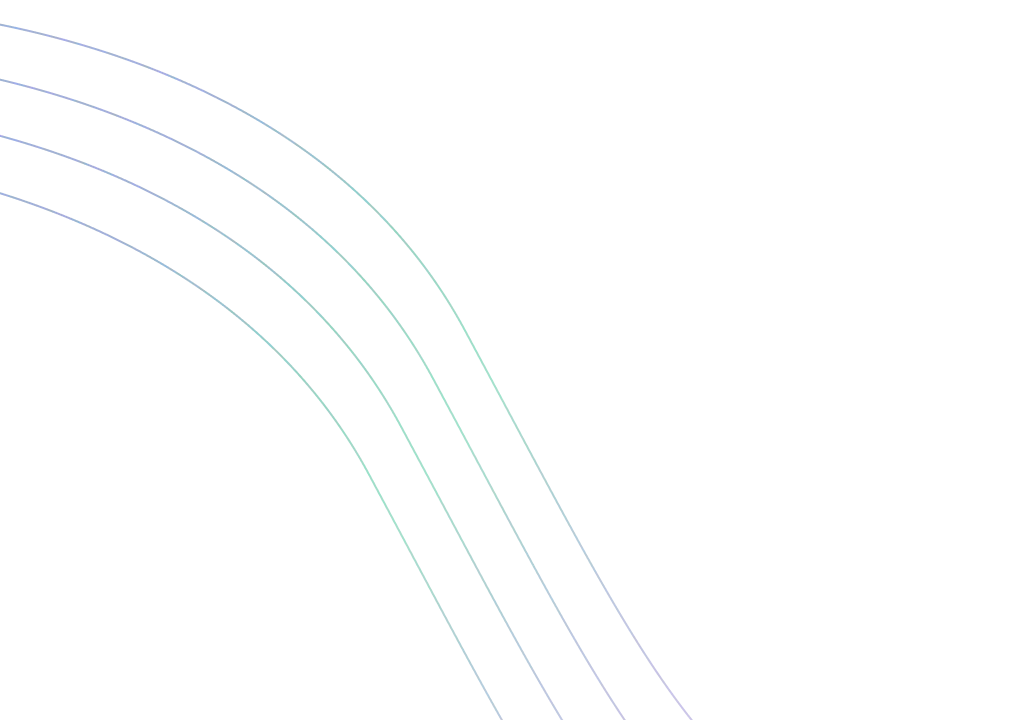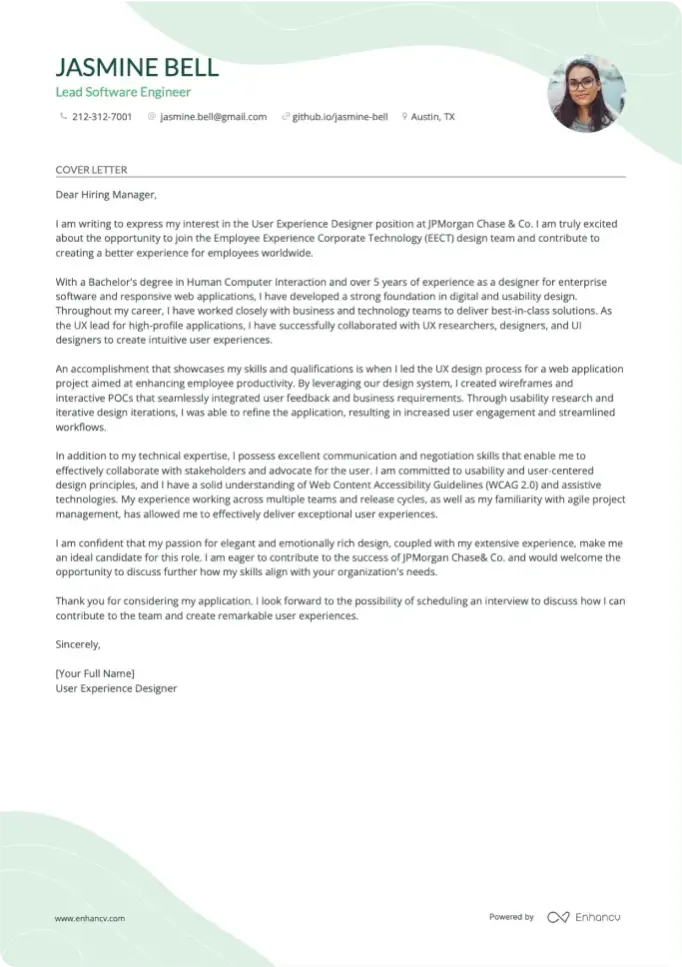You've found the ideal UX researcher job, and you're ready to apply, but then you hit a snag: crafting a compelling cover letter. It's not just about repeating your resume; your cover letter should spotlight a major success, weaving the story behind your proudest professional moment. Steer clear of the overused phrases that hiring managers see daily and keep it concise—aim for a single page that captures your unique qualifications and passion for user experience research.
- Making excellent use of job-winning real-life professional cover letters;
- Writing the first paragraphs of your ux researcher cover letter to get attention and connect with the recruiters - immediately;
- Single out your most noteworthy achievement (even if it's outside your career);
- Get a better understanding of what you must include in your ux researcher cover letter to land the job.
Let the power of Enhancv's AI work for you: create your ux researcher cover letter by uploading your resume.
If the ux researcher isn't exactly the one you're looking for we have a plethora of cover letter examples for jobs like this one:
- UX Researcher resume guide and example
- Character Designer cover letter example
- Game Designer cover letter example
- Set Designer cover letter example
- Character Animator cover letter example
- Designer cover letter example
- Logo Designer cover letter example
- Senior Graphic Designer cover letter example
- Electrical Designer cover letter example
- Digital Designer cover letter example
- Associate Creative Director cover letter example
Drop your resume here or choose a file.
PDF & DOCX only. Max 2MB file size.
UX researcher cover letter example
Vanessa Ford
Charlotte, North Carolina
+1-(234)-555-1234
help@enhancv.com
- Highlighting relevant work experience by providing specific details about past projects can strengthen a candidate's position. In the cover letter, the mention of leading the research process for a significant project at IBM and the resulting user satisfaction increase demonstrates tangible success and relevant experience.
- Quantifying achievements such as the 30% increase in user satisfaction provides concrete evidence of the candidate’s impact. Such metrics can be very persuasive, as they offer a clear measure of success and competency.
- Expressing how the candidate's skills align with the company's goals bridges the gap between individual experiences and organizational needs. In the cover letter, the candidate's ability to realign stakeholder goals with user needs showcases an understanding of key UX Researcher responsibilities.
- Showing enthusiasm for the role and the company can help to differentiate the candidate from others. The cover letter should reflect an understanding of the company’s values and articulate a genuine interest in contributing to its goals, as seen in the candidate's eagerness to bring a blend of methodical research and user-centric focus to the team.
What are the basics of the design or format of your ux researcher cover letter?
To start, here's a reminder for you: the Applicant Tracker System (or software that is used to assess candidate profiles), won't be reading your ux researcher cover letter.
Recruiters enjoy reading ux researcher cover letters with a standardized format that uses:
- the same font as the resume (e.g. modern ones like Raleway or Volkhov are prefered over the clichéd Times New Roman or Arial);
- single spacing to keep the content concise and organized (this is all ready for you in our cover letter templates);
- a one-inch margin to wrap around the text, like in our cover letter builder;
- PDF as a file format, as it allows your design (and visual element) to stay the same.
Finally, we can't go on without mentioning the key sections of your ux researcher cover letter.
In the top one-third, make sure to include a header (with your contact information, name, role, and date), a salutation, and an introduction.
Next, follows the heart and soul of your ux researcher cover letter or its body.
End your ux researcher cover letter with a closing paragraph and, if you wish, a signature.
Cut down the time spent on cover letters. Use our free cover letter generator to create one in seconds.
The top sections on a ux researcher cover letter
- Header: Includes your contact information, the date, and the recruiter's details, which is essential for a professional presentation and ensures the recruiter can easily contact you after reviewing your application.
- Greeting: Addresses the hiring manager or recruiter by name if known, which demonstrates attention to detail and personalization, qualities valuable in user experience research where understanding the audience is key.
- Introduction: Clearly states your interest in the UX Researcher position and briefly mentions your background, as it hooks the reader's interest and establishes the relevance of your application to the role.
- Body: Describes relevant experience, skills, and specific accomplishments in UX research, emphasizing how these can contribute to the success of the prospective employer, which is crucial for highlighting your qualifications and fit for the job.
- Closing: Ends with a call to action, such as expressing eagerness to discuss your application further in an interview, and a courteous sign-off, indicating professionalism and your proactive interest in the UX Researcher role.
Key qualities recruiters search for in a candidate’s cover letter
- Proven track record of conducting user research: Demonstrates hands-on experience in employing various research methods such as usability studies, interviews, surveys, and A/B testing, showing the candidate can gather and analyze user feedback effectively.
- Strong analytical skills: Essential for interpreting data, identifying patterns, and converting user feedback into actionable insights to inform design and product decisions.
- Empathy for users: The ability to understand and share the feelings of others is crucial in UX research to advocate for user needs and design meaningful, user-centered solutions.
- Collaboration and communication abilities: Necessary for working effectively within multi-disciplinary teams and communicating findings to stakeholders, designers, and developers in a clear, impactful manner.
- Understanding of UX design principles: Shows that the researcher can align their research with design objectives and contribute to creating intuitive and effective user interfaces.
- Experience with research tools and technologies: Familiarity with platforms like UserTesting, Optimal Workshop, or similar user research software indicates the ability to leverage the right tools to gather and analyze user data efficiently.
Personalizing your ux researcher cover letter salutation
Always aim to address the recruiter from the get-go of your ux researcher cover letter.
Use:
- the friendly tone (e.g. "Dear Paul" or "Dear Caroline") - if you've previously chatted up with them on social media and are on a first-name basis;
- the formal tone (e.g. "Dear Ms. Gibbs" or "Dear Ms. Swift") - if you haven't had any previous conversation with them and have discovered the name of the recruiter on LinkedIn or the company website;
- the polite tone (e.g. "Dear Hiring Manager" or "Dear HR Team") - at all costs aim to avoid the "To whom it may concern" or "Dear Sir/Madam", as both greetings are very old-school and vague.
List of salutations you can use
- Dear Hiring Manager,
- Dear [Company Name] Team,
- Dear [Department Name] Hiring Committee,
- Dear [Specific Contact Person's Name],
- Esteemed Colleagues,
- Dear [Mr./Ms./Dr.] [Last Name],
What to include in those first two sentences, or your ux researcher cover letter introduction
Have you ever wondered what the best way is to present your profile in the ux researcher cover letter introduction?
There's no right or wrong answer if you're being concise and authentic to yourself.
Some professionals start their ux researcher cover letter by:
- congratulating the company - focusing on something impressive, whether that's an award, an industry-leading project, or a key event;
- aligning their passion for the field or industry with the job - if you're enthusiastic about what you do, you'd thus grow your skill set and value as a professional.
What to write in the body of your ux researcher cover letter
Now that you've got your intro covered, here comes the heart and soul of your ux researcher cover letter.
It's time to write the middle or body paragraphs. This is the space where you talk about your relevant talent in terms of hard skills (or technologies) and soft (or people and communication) skills.
Keep in mind that the cover letter has a different purpose from your ux researcher resume.
Yes, you still have to be able to show recruiters what makes your experience unique (and applicable) to the role.
But, instead of just listing skills, aim to tell a story of your one, greatest accomplishment.
Select your achievement that:
- covers job-crucial skills;
- can be measured with tangible metrics;
- shows you in the best light.
Use the next three to six paragraphs to detail what this success has taught you, and also to sell your profile.
Closing remarks to end your ux researcher cover letter
Of course, you'll have to show gratitude to the recruiters, who have assessed your profile at the end of your ux researcher cover letter .
A "Thank you for the consideration" would work wonders, instead of the standard "Sincerely yours".
Do you want to make an even better impression?
Close off your ux researcher cover letter by promising how you see yourself excelling in the role and the positive impact you'd bring about.
A sentence that encourages some further action on the recruiter's end could also be a good way to close off the communication (e.g. provide your availability for an interview).
No experience ux researcher cover letter: making the most out of your profile
Candidates who happen to have no professional experience use their ux researcher cover letter to stand out.
Instead of focusing on a professional achievement, aim to quantify all the relevant, transferrable skills from your life experience.
Once again, the best practice to do so would be to select an accomplishment - from your whole career history.
Another option would be to plan out your career goals and objectives: how do you see yourself growing, as a professional, in the next five years, thanks to this opportunity?
Be precise and concise about your dreams, and align them with the company vision.
Key takeaways
Summarizing the most important aspects in writing your ux researcher cover letter, remember to:
- Create a personalized ux researcher cover letter for each role you apply for, that includes the recruiter's name in the salutation;
- Format your ux researcher cover letter with single-spacing, one-inch margins, and a modern, yet ATS-friendly font;
- Always start off your ux researcher cover letter with two sentences that reflect what is most important about your application;
- Your ux researcher cover letter body should feature your biggest accomplishments and the job-relevant skills it has taught you;
- Instead of opting for the "Sincerely yours" ending, close your ux researcher cover letter with a nod to the future with what you aim to achieve in this potential role.




